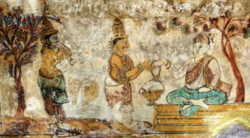Aditha Karikalan
This article has multiple issues. Please help improve it or discuss these issues on the talk page. (Learn how and when to remove these messages)
|
| Aditha Karikalan | |
|---|---|
| Virapandiyan Thalai Konda Koparakesari Varman Karikalan | |
 Mural of Prince Aditha Karikalan at Brihadisvara Temple | |
| Co-Regent of the Chola Empire | |
| Reign | 966 – 971 CE |
| Emperor | Parantaka II |
| Predecessor | Parantaka II |
| Successor | Uttama Chola |
| Born | Aditha Karikalan 942 CE Tirukoilur, Chola Empire (modern day Tamil Nadu, India) |
| Died | 971 CE (aged 29) Melakadambur, Chola Empire |
| Spouse | Ilaada Madeviyar |
| Issue | Karikala Kannan |
| Dynasty | Chola |
| Father | Parantaka II |
| Mother | Vanavan Mahadevi |
| Religion | Hinduism |
| Chola kings and emperors |
|---|
| Interregnum (c. 200 – c. 848 CE) |
| Related |
Aditya II (942 CE – 971 CE), also known as Aditha Karikalan, was a Chola prince who lived in the 10th century in India.[1] He was born in Tirukoilur and was the eldest son of Parantaka Chola II. He was the elder brother of Rajaraja Chola I and Kundavai. He was called Virapandiyan Thalai Konda Koparakesari Varman Karikalan.[2]
Early life
[edit]
Aditha Karikalan was the elder son of the Chola king Parantaka II (alias Sundara) and queen Vanavan Mahadevi.[3] He was the elder brother of Rajaraja Chola and Kundavai.
He led the Chola expedition against the Pandyas and defeated the Pandya king Veerapandyan at the Battle of Chevur. He killed Veerapandiyan after chasing him on the banks of Vaigai river.According to the Esalam bronze and copper plates discovered at Esalam village in Tamil Nadu, Aditha Karikalan conquered the Pandya ruler in battle and beheaded him.[4] Aditha was made the co-regent and heir apparent to the Chola throne even though Uttama Chola, the son of Gandaradita Chola, had more right to the throne. Aditha Karikalan was assassinated. Aditha was succeeded by Uttama Chola.[5]
The Udaiyarkudi stone inscriptions in Anandheeswarar temple at present day Udaiyarkudi in Tamil Nadu names the killers - Soman Sambavan, Ravidasan alias Panchavan Brammadhirajan, Parameswaran alias Irumudichozha Brammadhirajan and Malaiyanooran.[6][7] The inscription also mentions the decree of Raja Raja confiscating the lands of the murderers. As per epigraphs, the inquiry into the death was completed in the second year of Rajaraja Chola I's reign and the lands of certain officials were confiscated for their complicity in the murder of "Karikala Chola who took the head of the Pandya".[8][9]
Historians are divided as to whether the inscription says that the confiscation was a direct royal order of Rajaraja or that the decree was giving permission for selling the land confiscated earlier from the killers.
According to archaeologist Kudavayil Balasubramanian, "Dr K T Tirunavukkarasu in his collection of historical essays titled "Arunmozhi Aiyvu Thogudi", comprehensively ruled out Madurantaka Uttama's role in Aaditha Karikala's murder. In the said article, basing his view on a number of historical data points, Dr Tirunavukkarasu has gone on to explain that there was a delay in apprehending the perpetrators immediately thereafter and it was only during Rajaraja I's second regnal year that the culprits were brought to book .[10] Suspicions were pointed to Uttama Chola, but confiscations of land belonging to culprits started before Raja Raja's period, suggesting that Uttama Chola did not spare the plotters. Among the punished were Ravidasan, Soman and Parameshwaran who were all government officials.[11][12][13]
In popular culture
[edit]- Ponniyin Selvan, a Tamil language historical fiction novel by Indian author Kalki Krishnamurthy, tells the story of the early days of Chola prince Arulmozhi Varman and features Aditha Karikalan as an important character.
- PS-1 and PS-2, movie adaptations by Indian director Mani Ratnam of the 1955 Ponniyin Selvan novel, feature Vikram as Aditha Karikalan.
References
[edit]- ^ A Topographical List of Inscriptions in the Tamil Nadu and Kerala states: Thanjavur district By T. Mahalingam
- ^ Nilakanta Sastri, K.A. (1955). A History of South India, OUP, New Delhi (Reprinted 2002)
- ^ Vidya Dehejia 2009, p. 42.
- ^ R. Nagaswamy. "Archaeological Finds in South India : Esâlam Bronzes and Copper Plates". Bulletin de l'École Française d'Extrême-Orient. 76: 14.
- ^ Nilakanta Sastri, K.A. (1935). The ChōĻas, University of Madras, Madras (Reprinted 1984)
- ^ Pandarathar, T. V. Sadasiva. Pirkaala Cholar Sarithiram (History of the Later Cholas) (in Tamil). Annamalai University. p. 79.
- ^ "பொன்னியின் செல்வன் கதாபாத்திரங்களின் பெயர்கள் கொண்ட கல்வெட்டுகள் - புகைப்படத் தொகுப்பு". Retrieved 7 May 2023 – via www.bbc.com.
- ^ Epigraphia Indica, Volume 21, page 167
- ^ S. R. Balasubrahmanyam. Early Chola Temples: Parantaka I to Rajaraja I, A.D. 907-985. Orient Longman, 1971. p. 76.
- ^ "Udayarkudi Inscription – An In-depth Assessment ( Translated article)". Archived from the original on 12 June 2020. Retrieved 9 August 2021.
- ^ South Indian History Congress (1999). Proceedings of the Annual Conference, Volume 18. p. 157.
- ^ Annals of Oriental Research, Volume 25. 1975. p. 600.
- ^ Early Indian Land Grants and State Economy. 1988. p. 175.
Works cited
[edit]- Vidya Dehejia (2009). The Body Adorned: Sacred and Profane in Indian Art. Columbia University Press. ISBN 978-0-231-51266-4.
